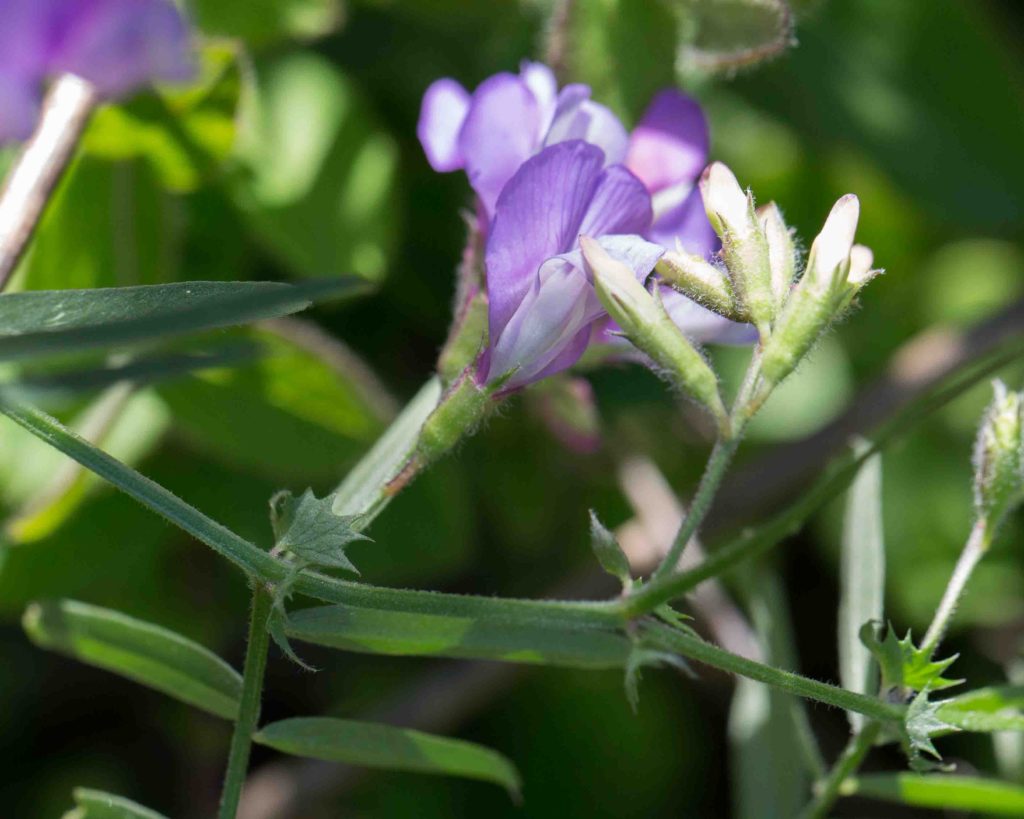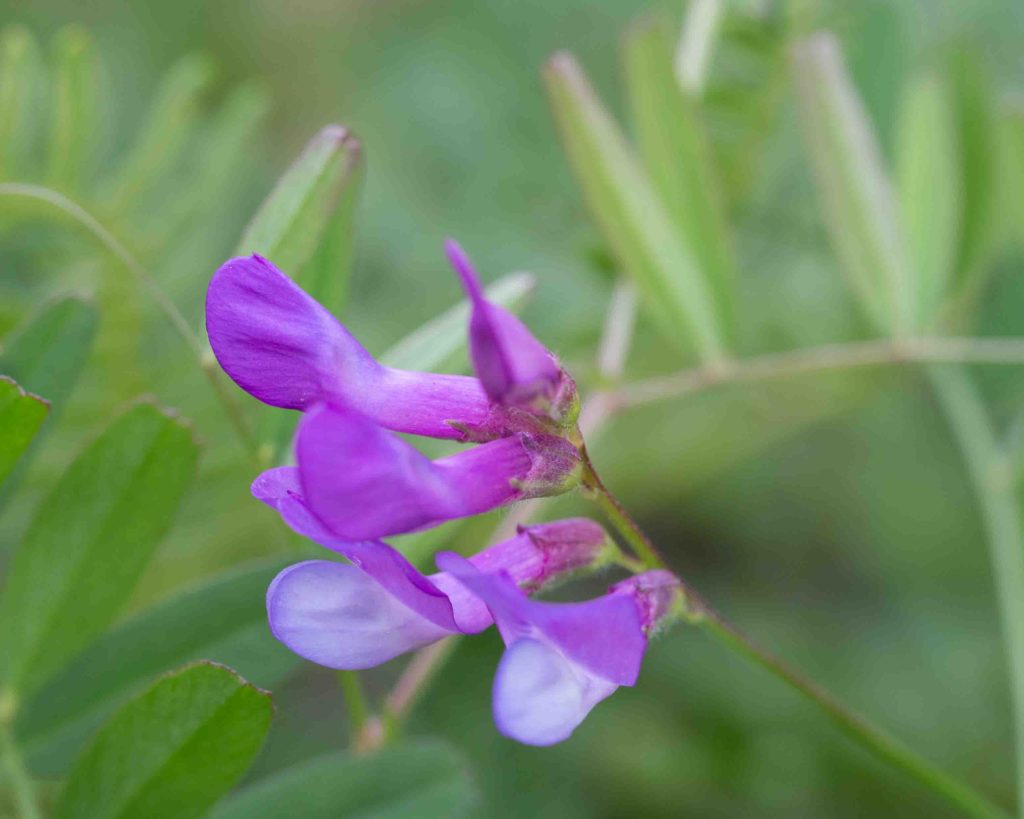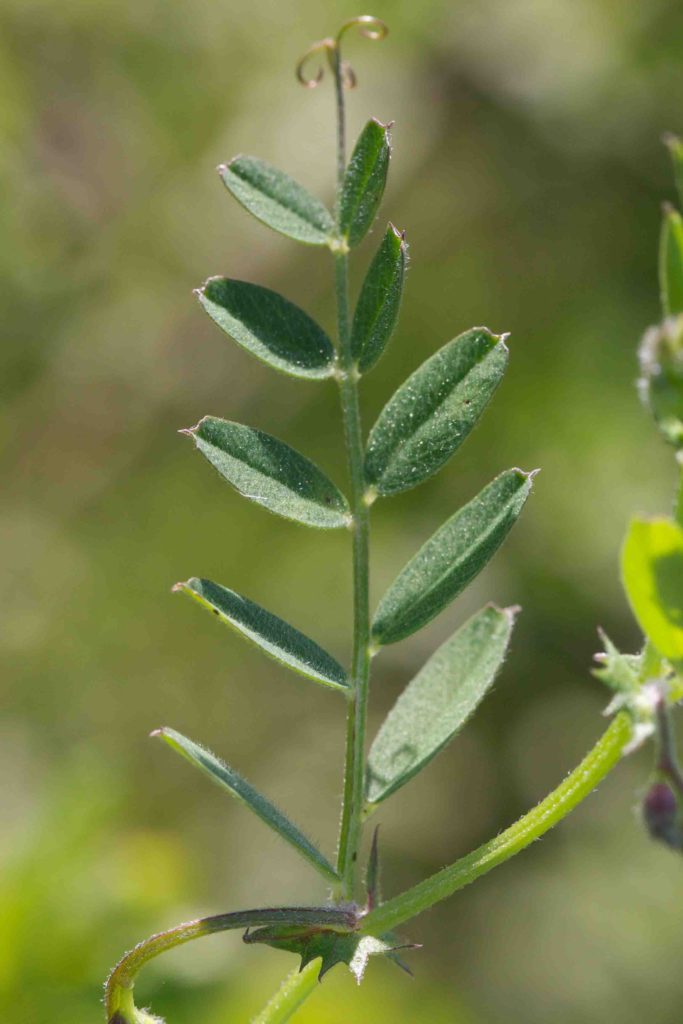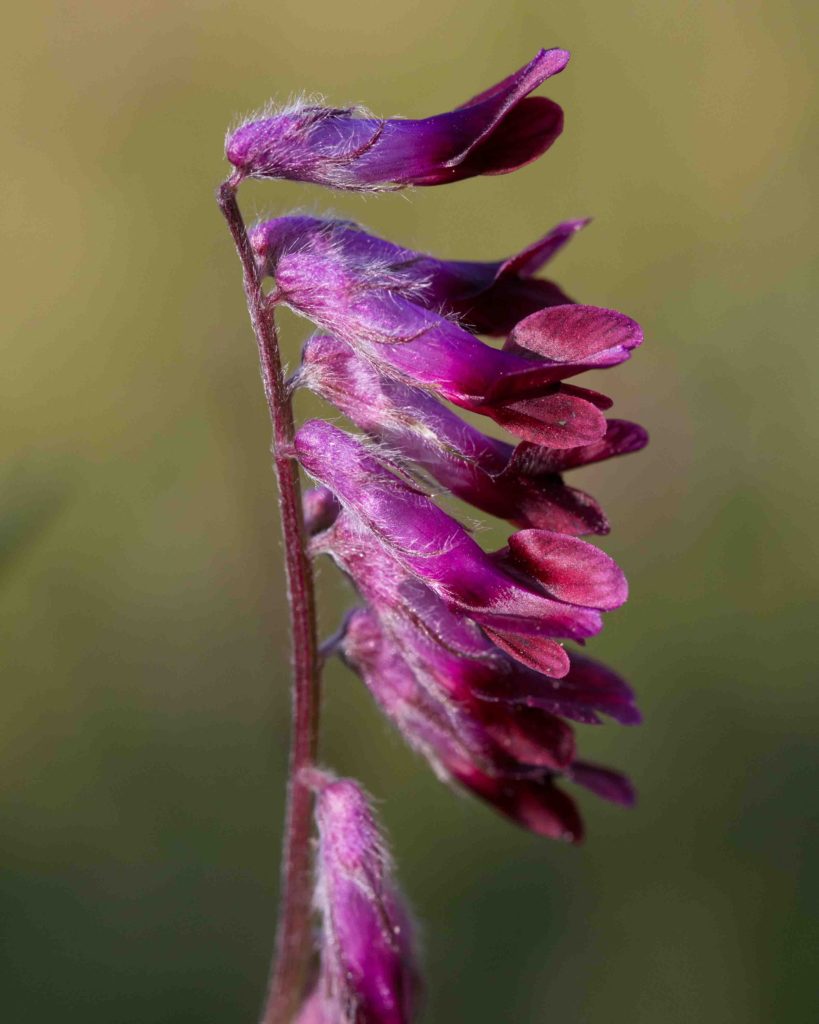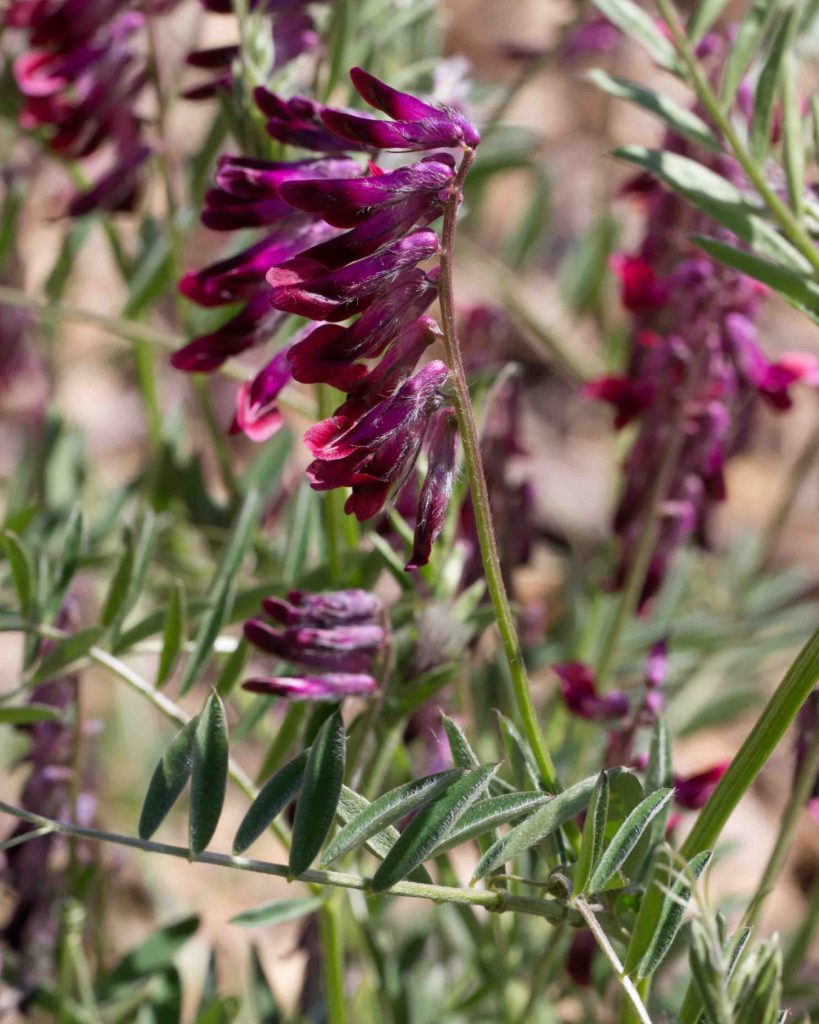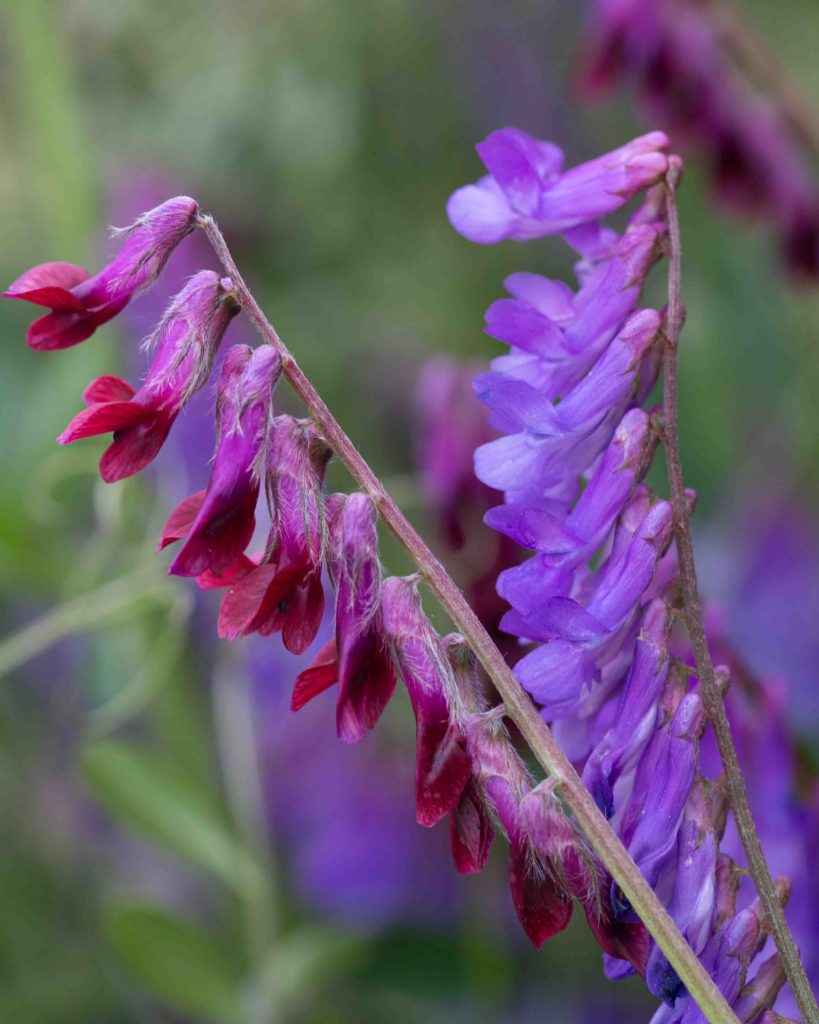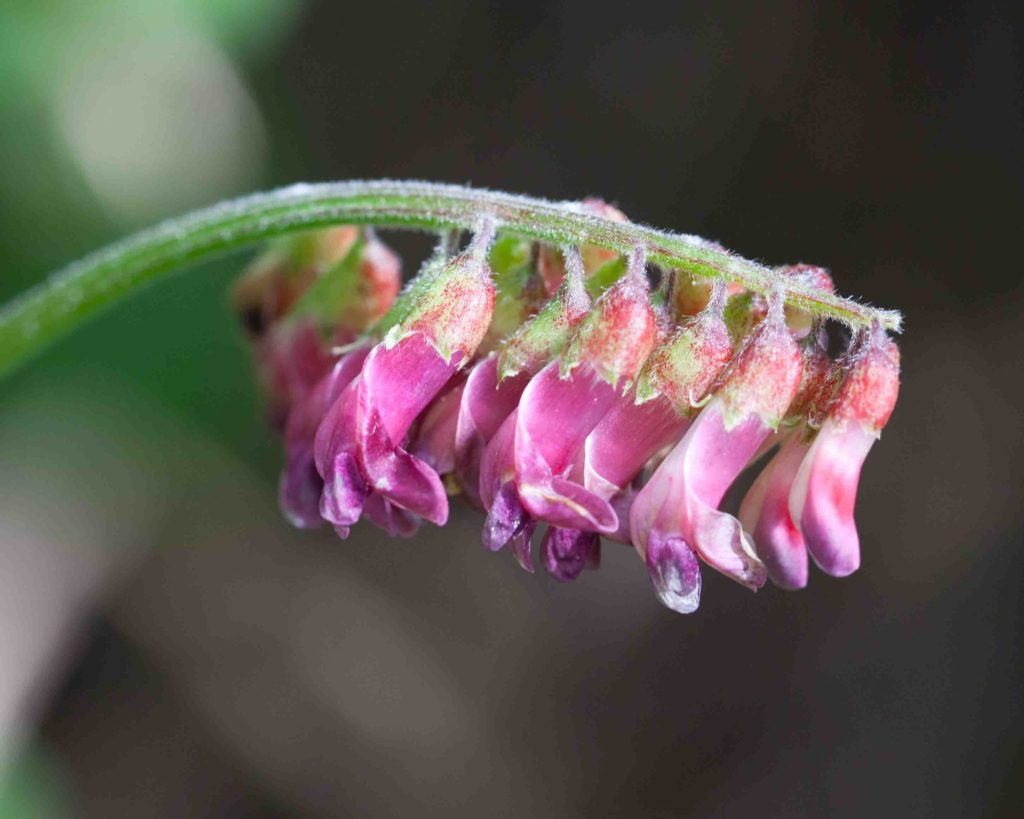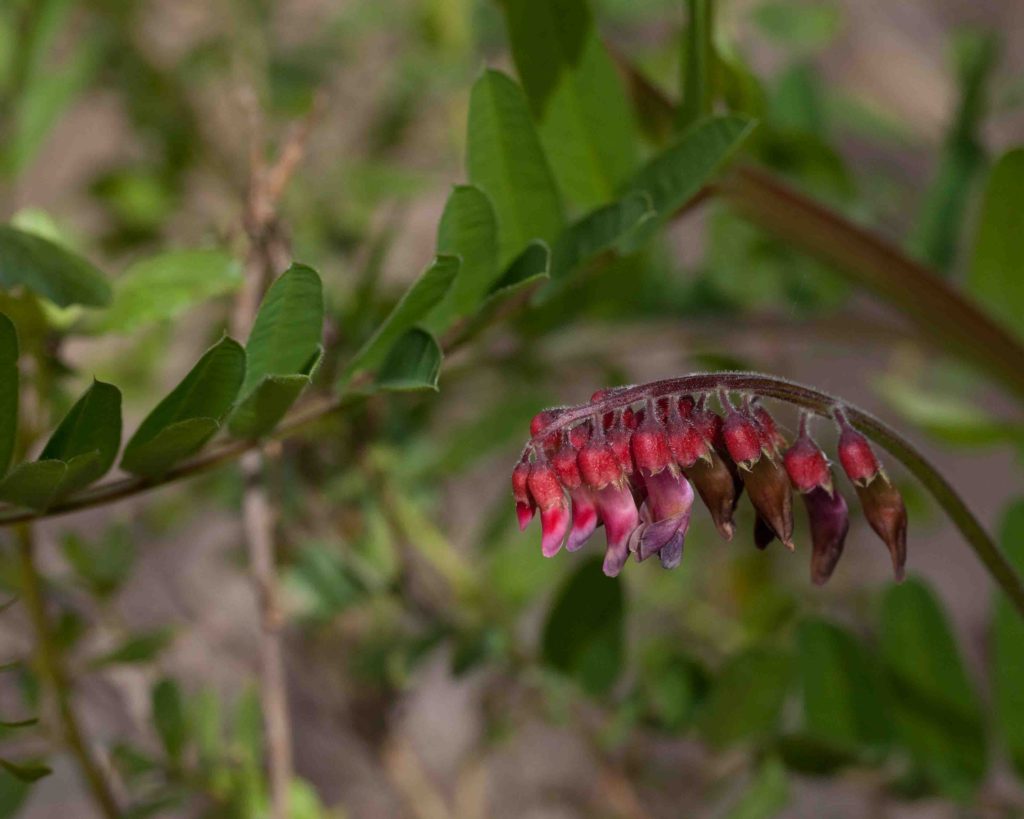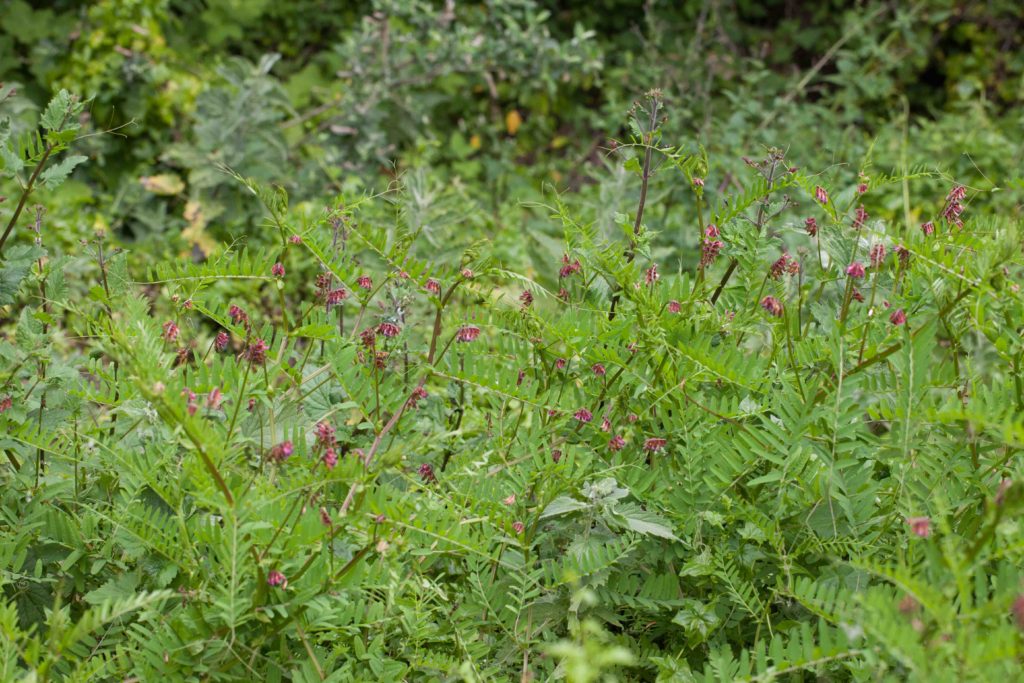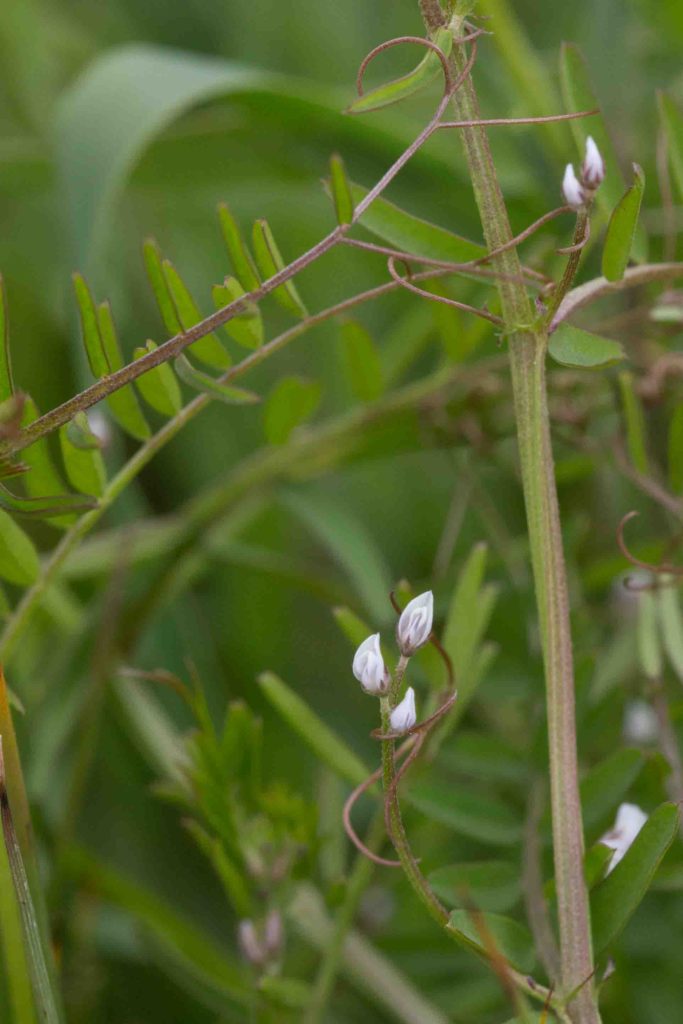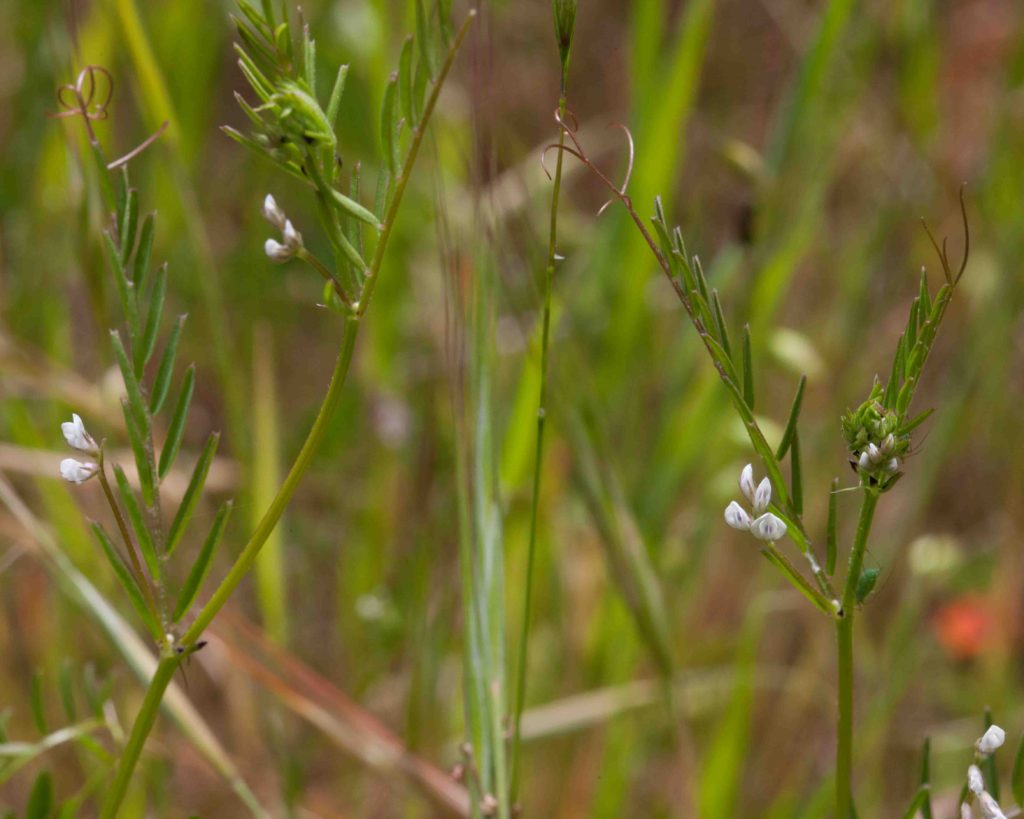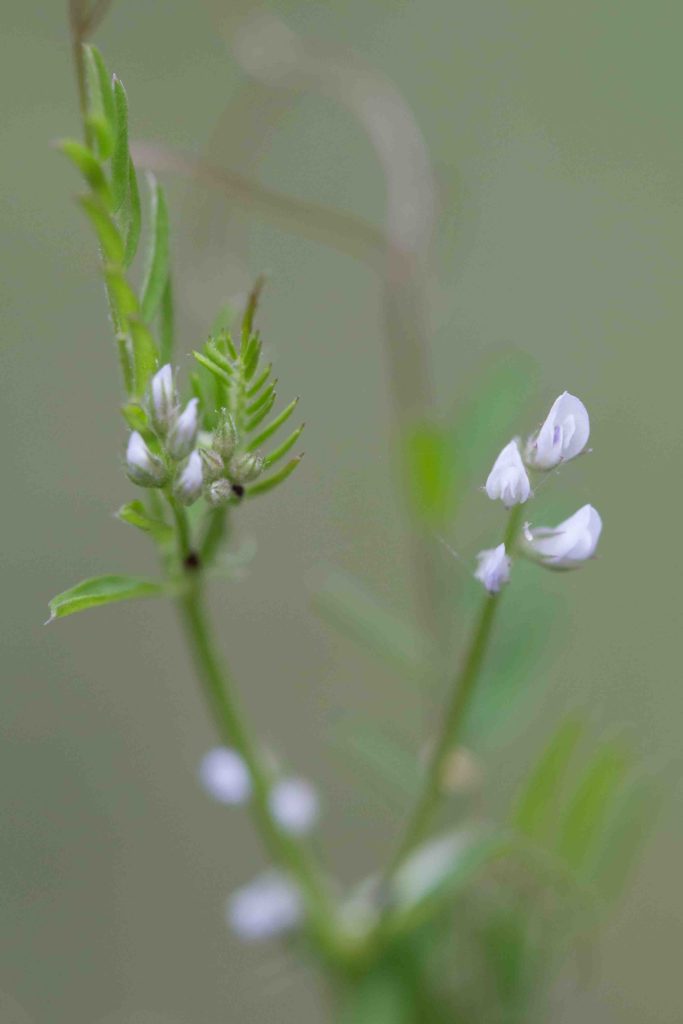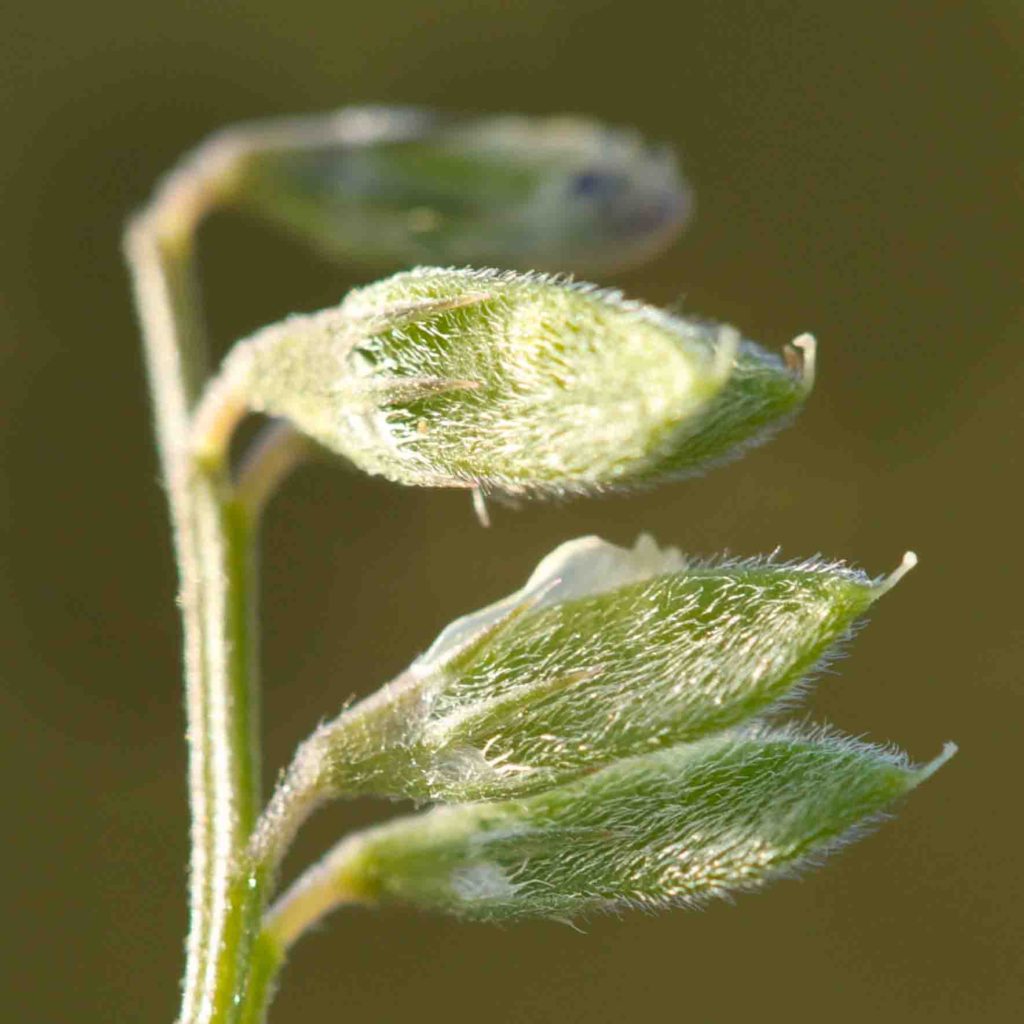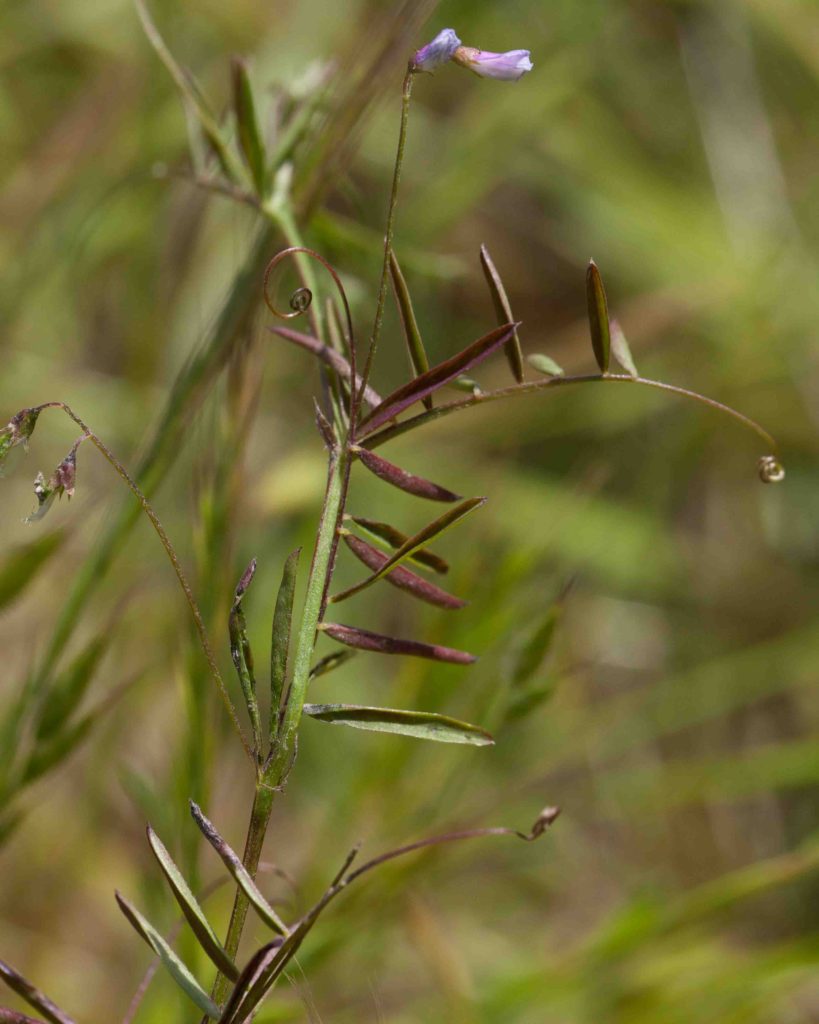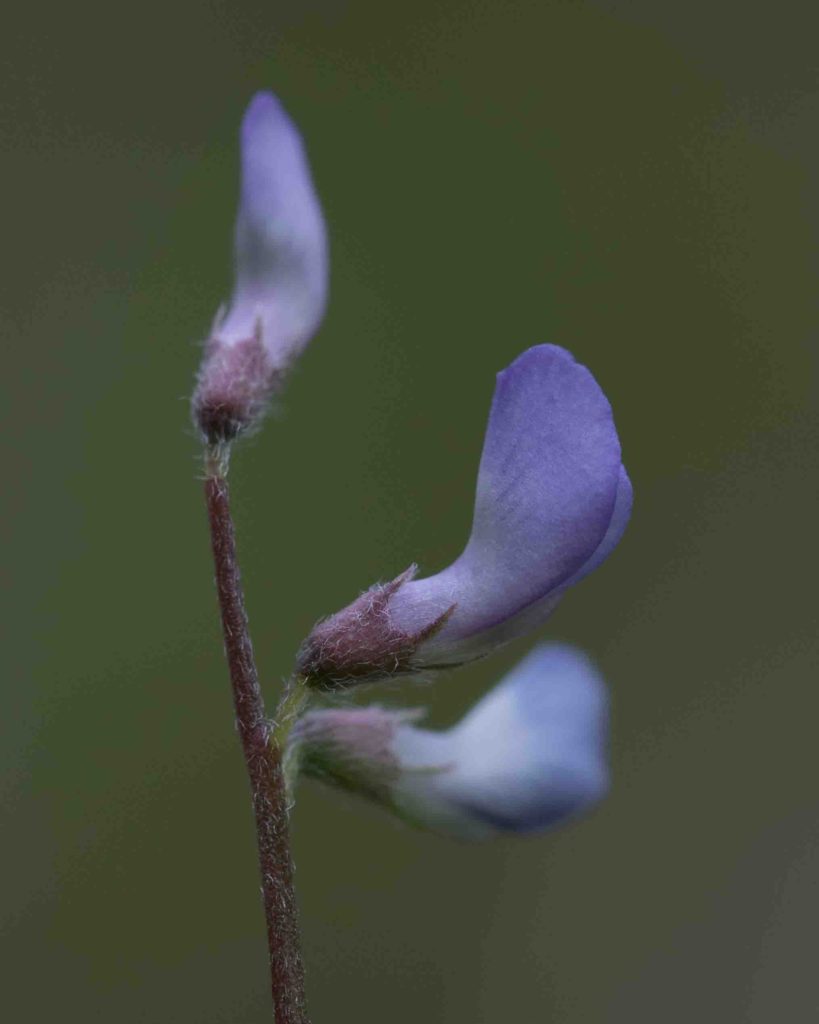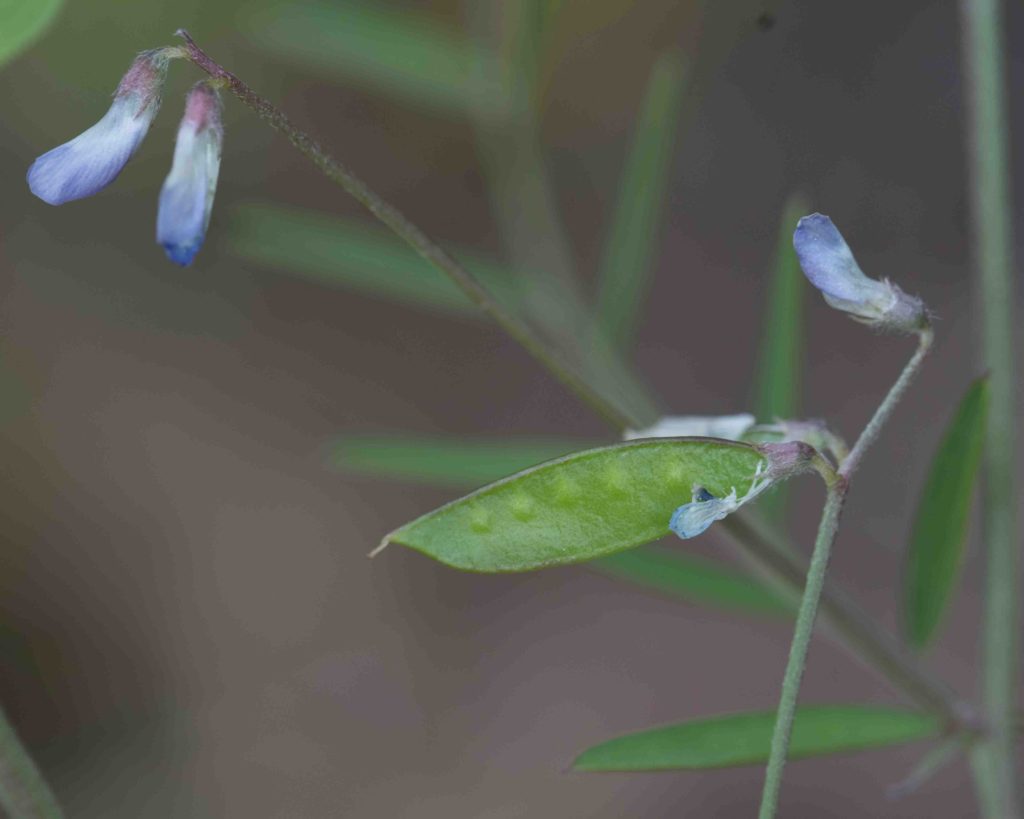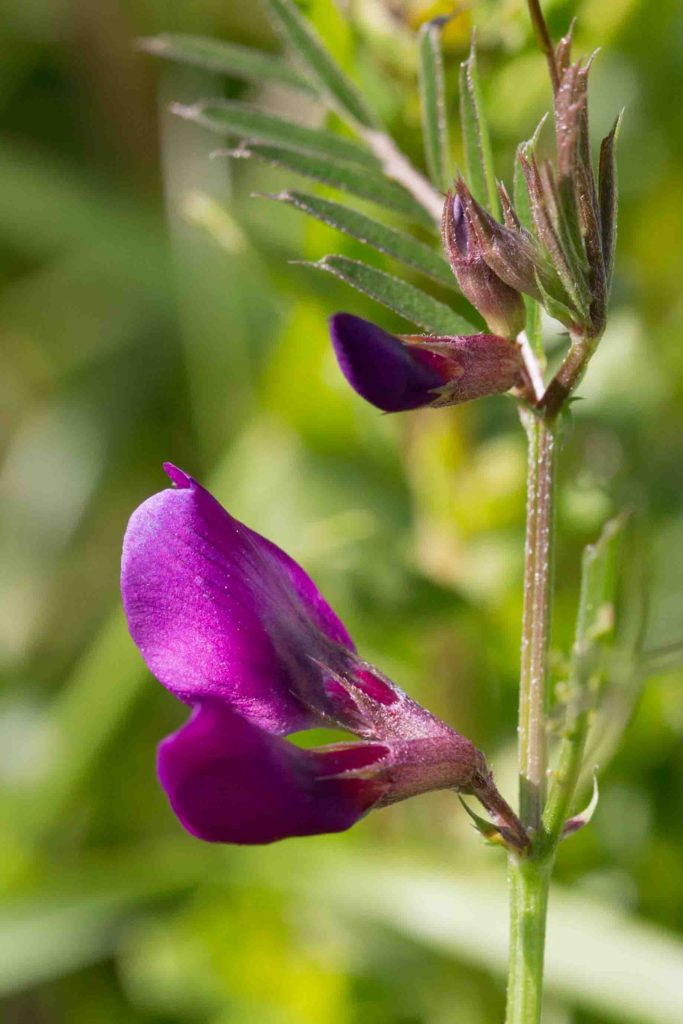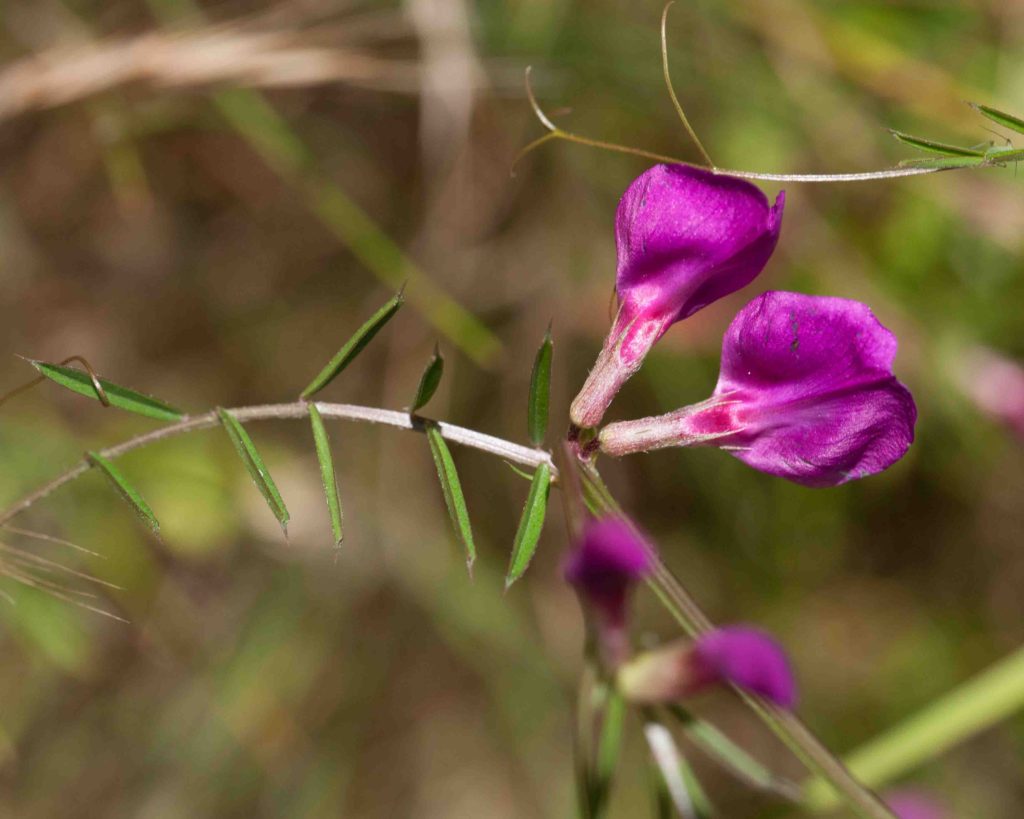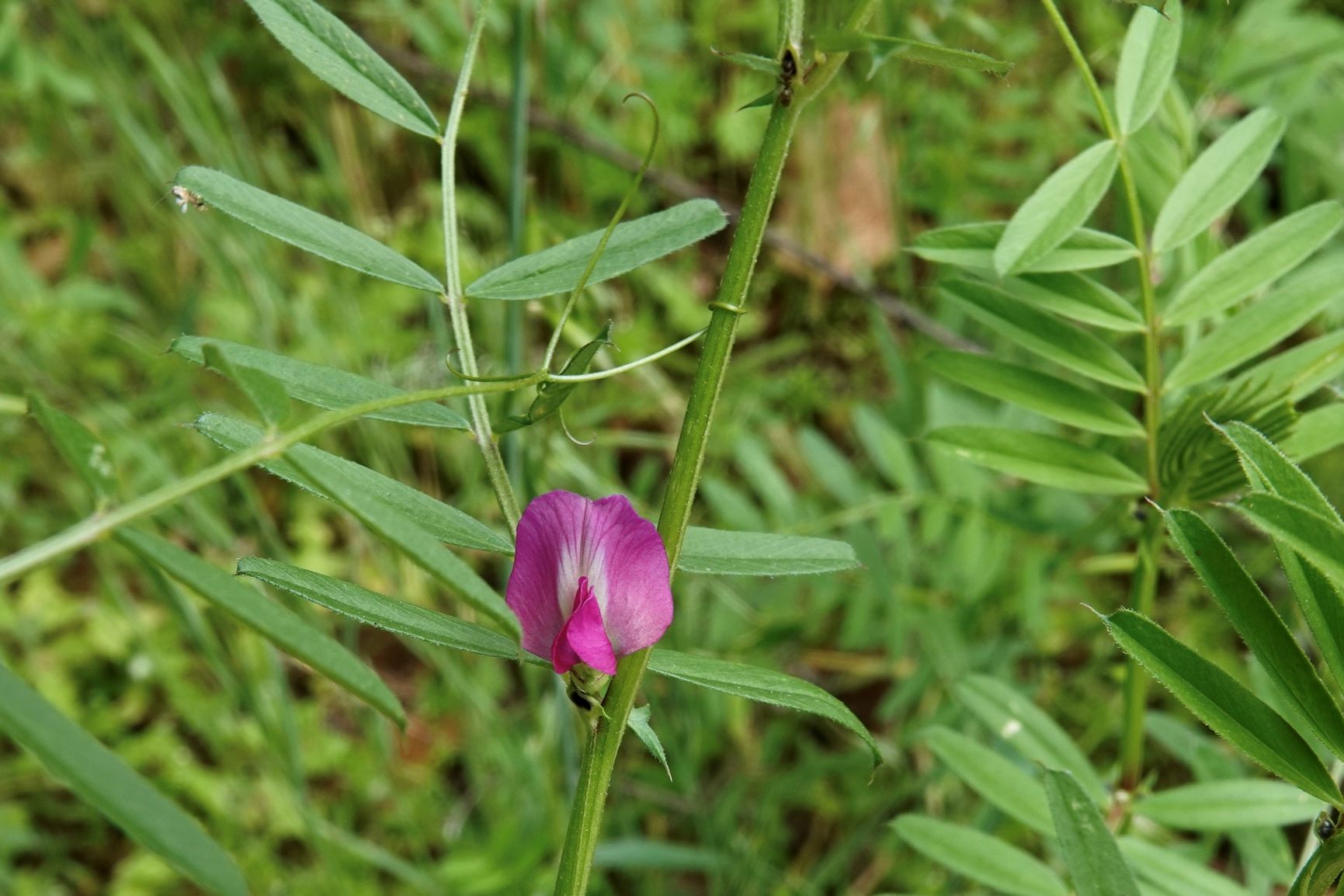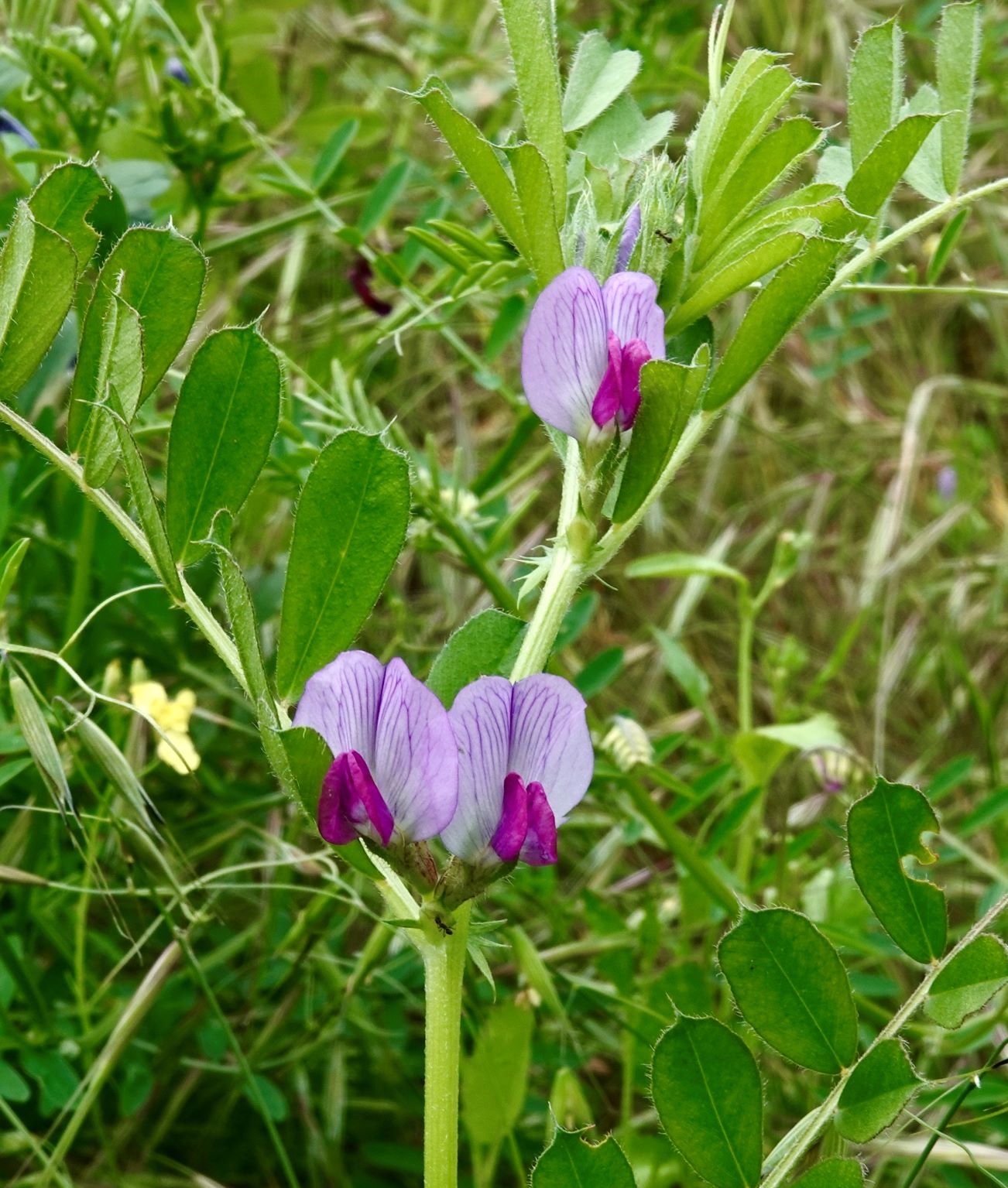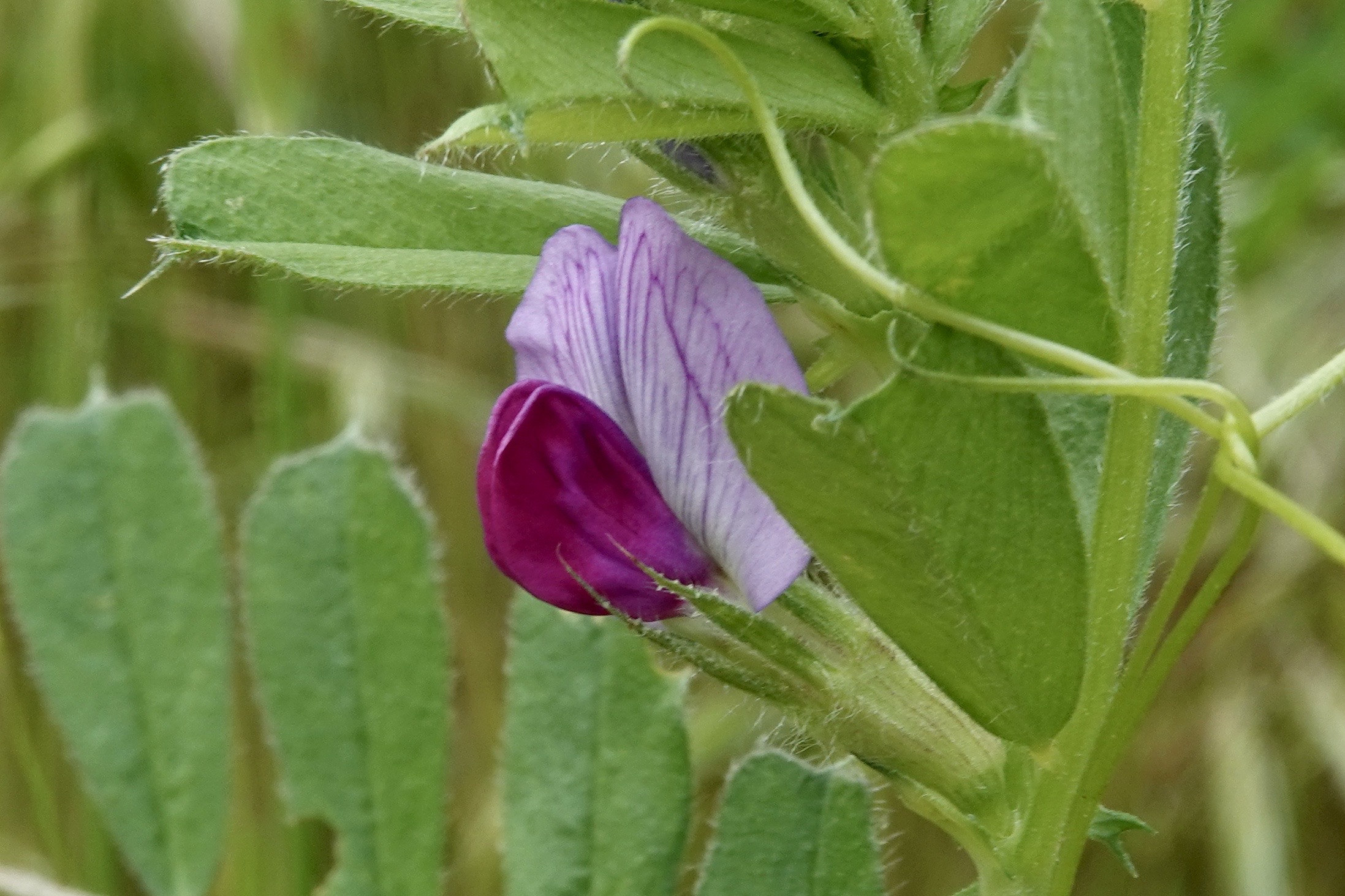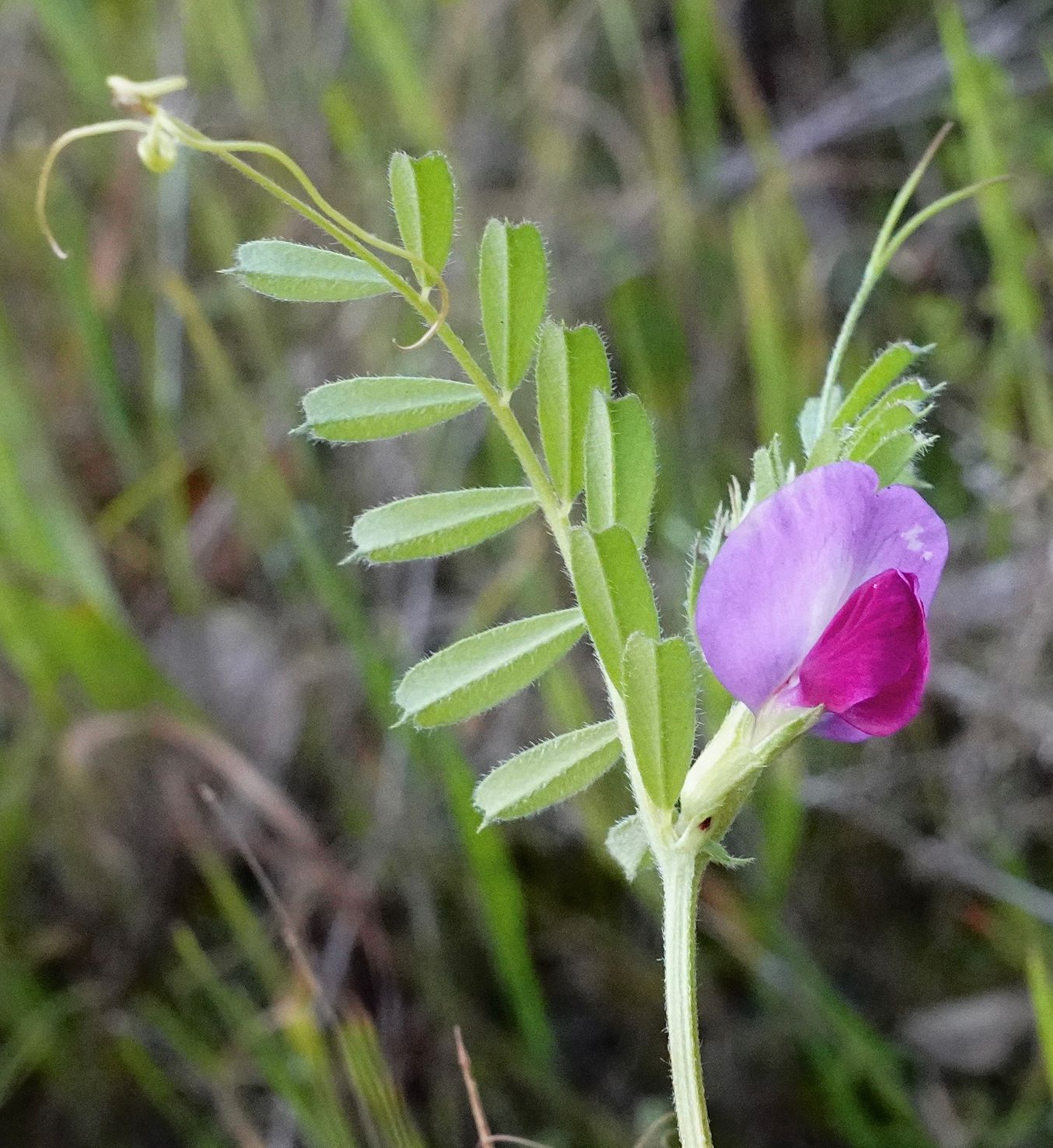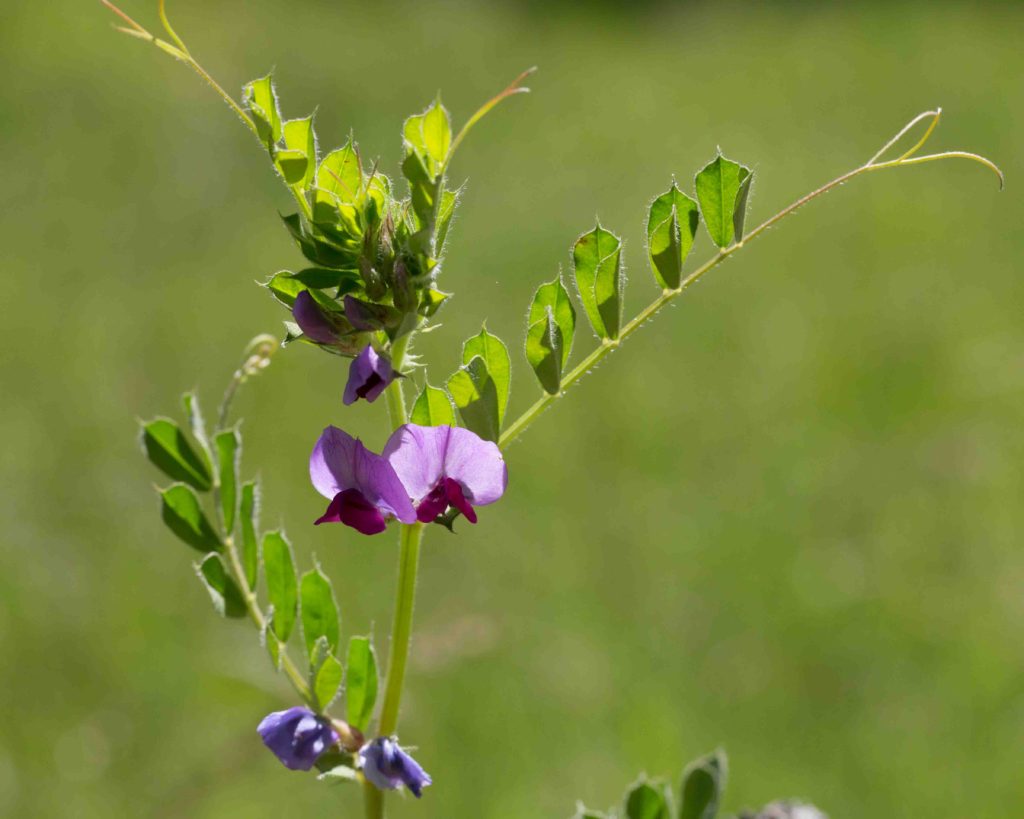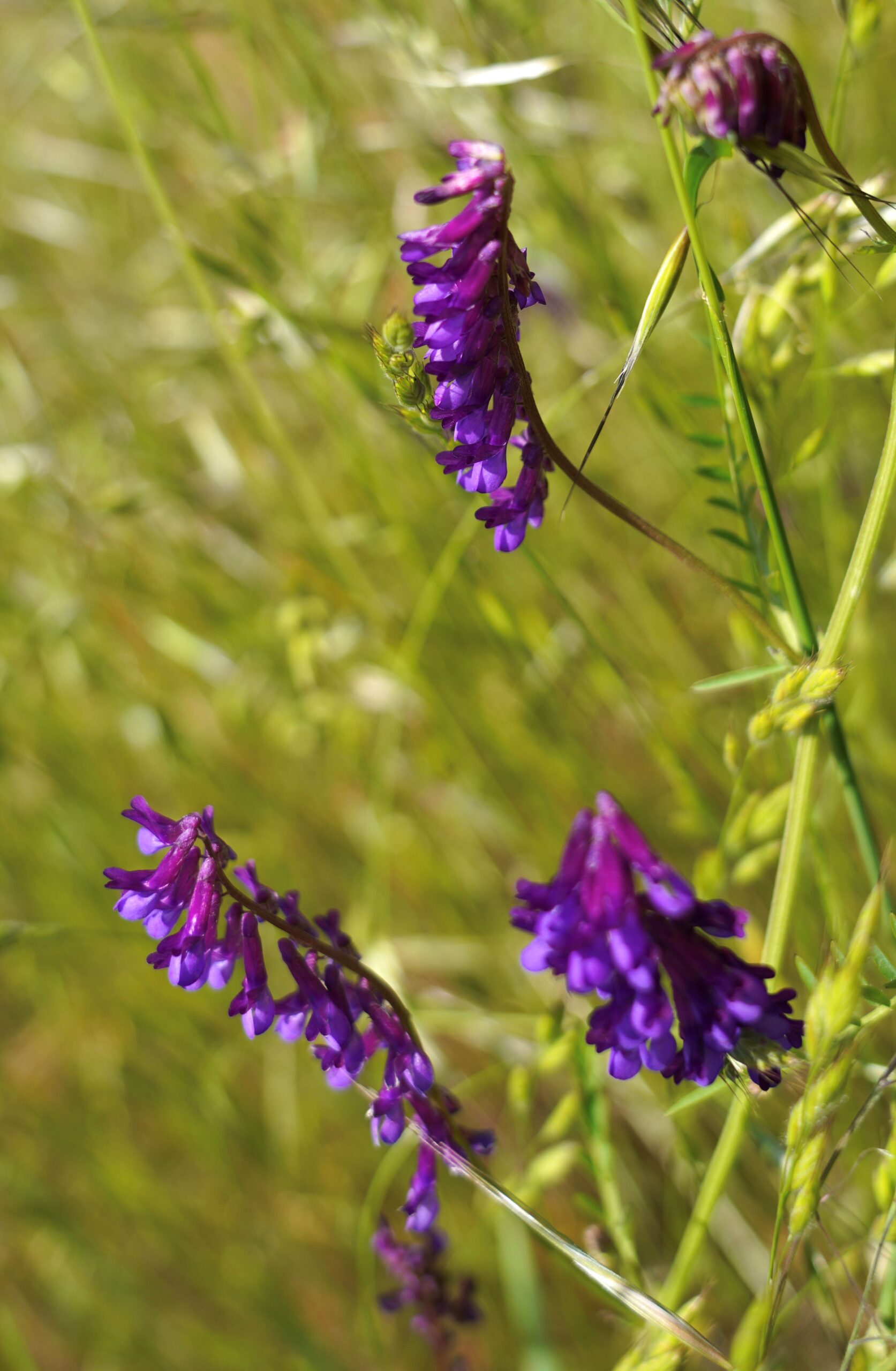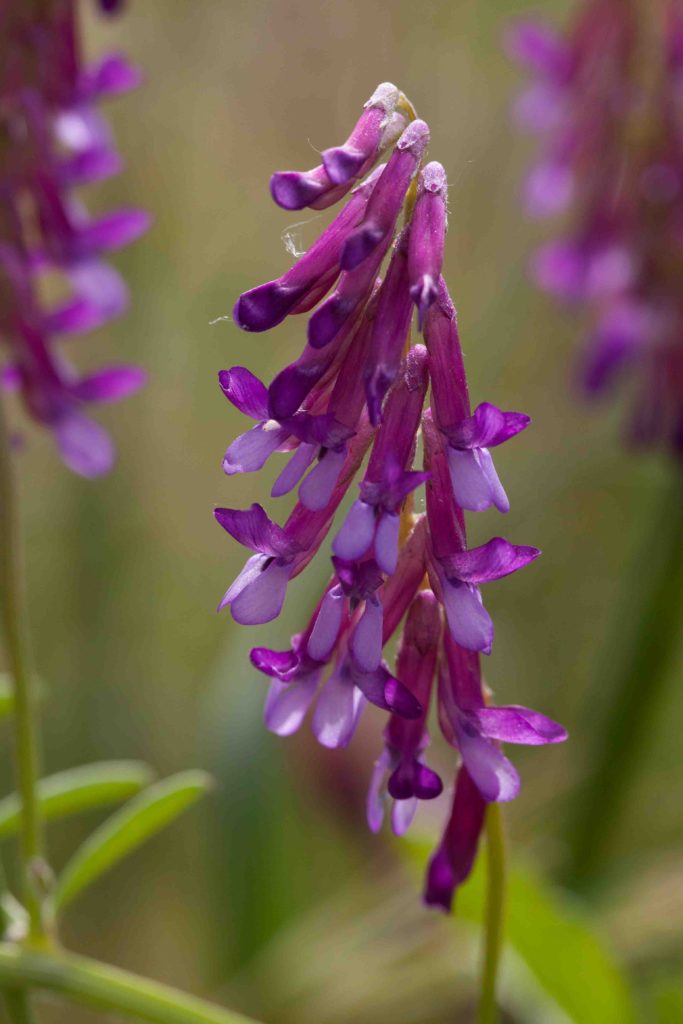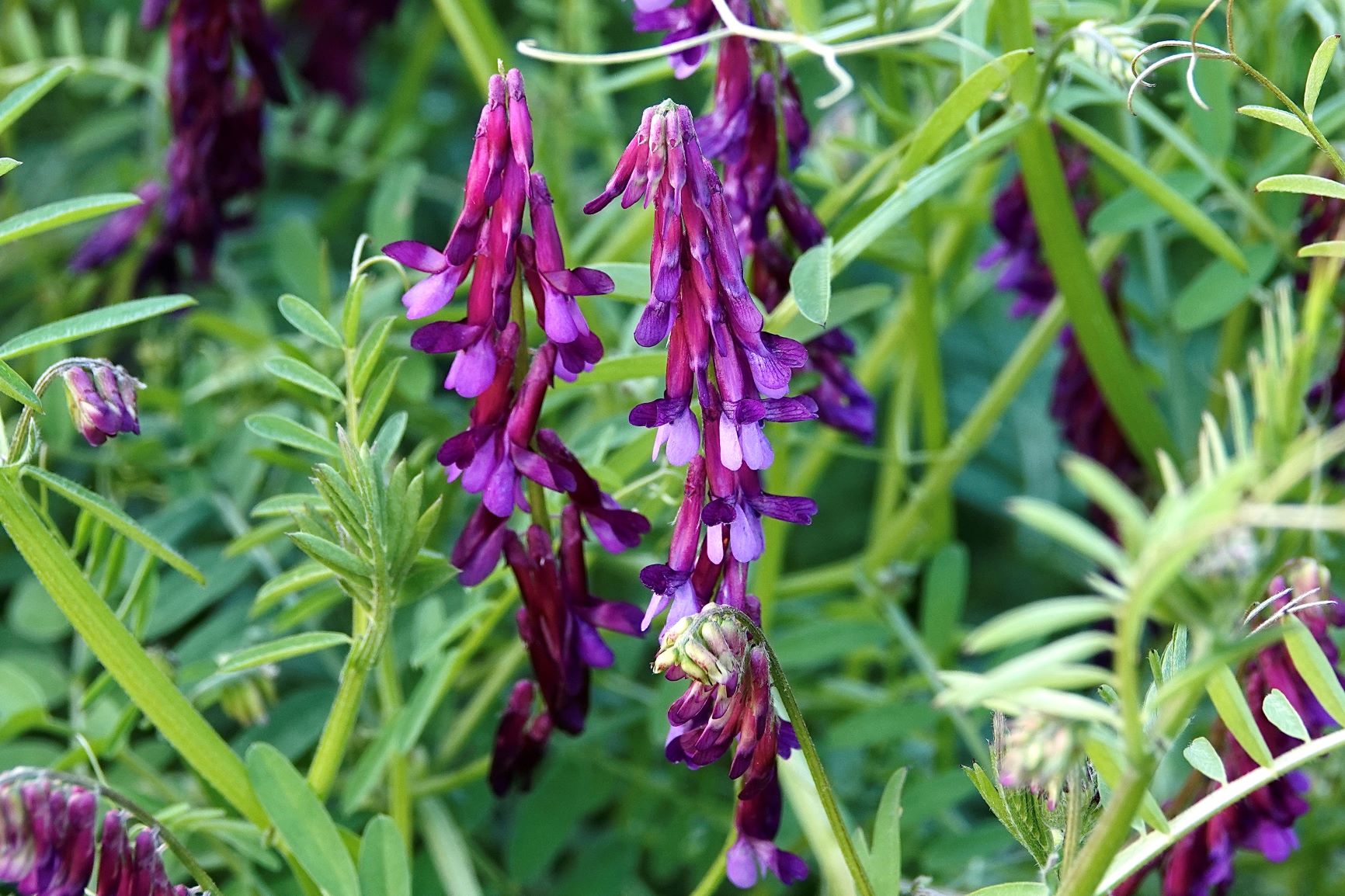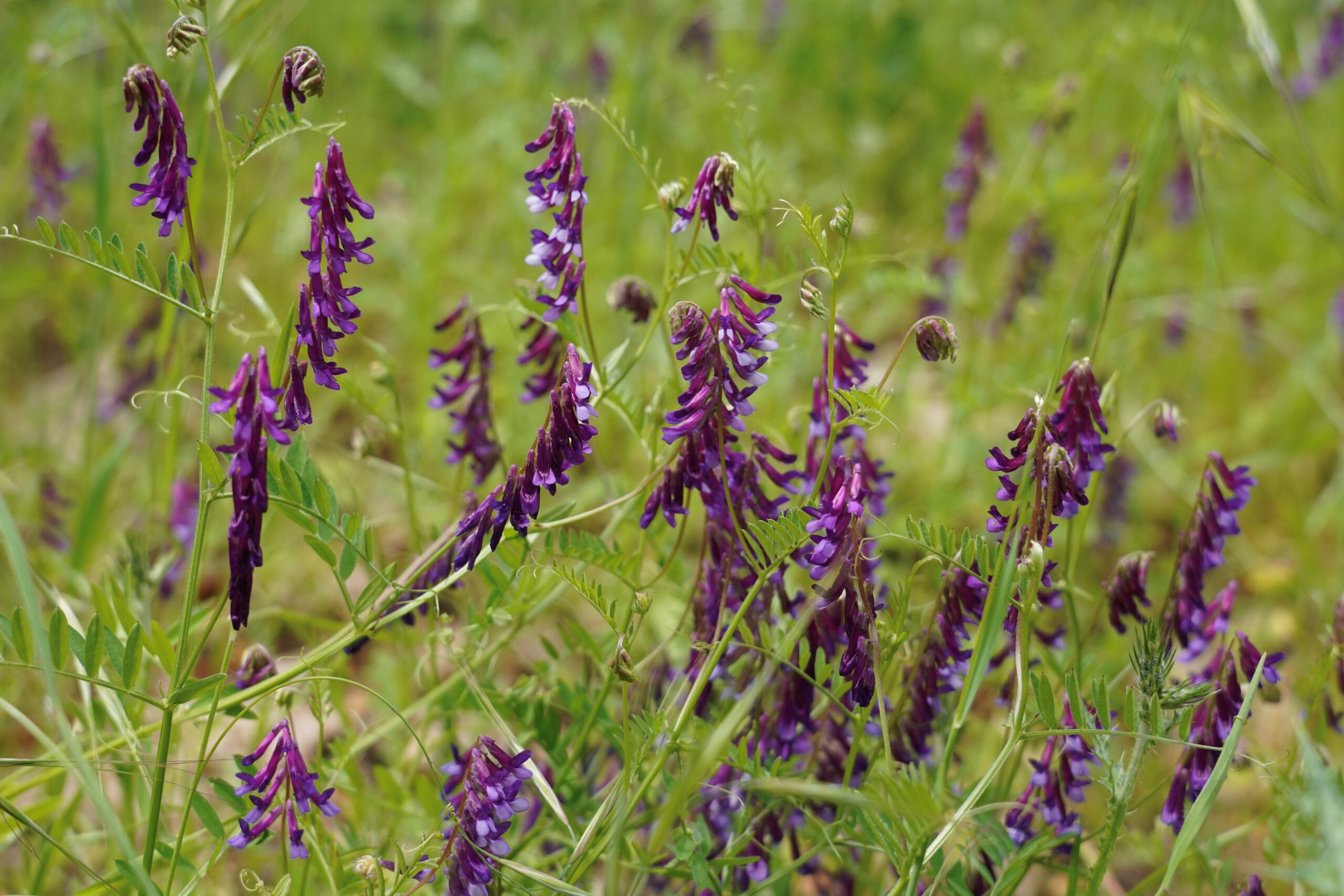Fabaceae: Pea Family — Vicia (Vetch)
The pea family has 5-petaled flowers, consisting of a wide upper banner petal, two wing petals, plus two lower petals which are fused to form a boat-shaped keel. Many produce heads or spikes, consisting of multiple individual flowers (examples are lupines and clovers). The seed pod is generally a “legume”. This is a long, flattish pod, swollen by the seeds, and splitting lengthwise along both the top and bottom.
American Vetch – Vicia americana subsp. americana
Blooms:
Mar–June
Plant Height:
< 1 m
Flower Size:
Medium cluster
Origin:
Native
Habitat:
Open, moist woodland, disturbed areas
Notes:
Easily confused with Pacific Pea (Lathyrus vestitus), but with some subtle differences. First, there are only 3–9 blue-purple to lavender flowers in the inflorescence (vs 8–15 for Pacific Pea). Second, the banner is bent back, but to varying degrees (vs bent back about 90°). Third, the style has hairs surrounding the tip (vs being limited to one side). Fourth, leaf stipules are consistently star-shaped, with several pointed lobes. Fifth, there can be as many as 16 leaflets on each leaf (vs a maximum of 12), with tips that may be acute, truncate, notched or toothed (vs tips that are rounded to obtuse),
Purple Vetch – Vicia benghalensis
Blooms:
Mar–June
Plant Height:
1–2 m
Flower Size:
Medium Cluster
Origin:
Europe
Habitat:
Grassland, roadsides, disturbed places
Notes:
Similar to Winter Vetch (Vicia villosa subsp. varia, see below) in appearance, but there are significant differences. First, it has fewer leaflets (4–8 pairs as against 6–12). Second, it has fewer flowers (3–10 as against 10–20), which are dark or red-purple rather than lavender. The photo on the right show both subspecies for comparison. Third, the stems and leaves are noticeably hairy, as is the flower tube. The long, linear calyx lobes are prominently plumose.
Note: Yeager & Mitchell’s Monterey County Wildflowers – a Field Guide incorrectly identifies this plant as Woolly Vetch (Vicia villosa subsp. villosa).
Giant Vetch – Vicia gigantea
Blooms:
Mar–Aug
Plant Height:
1–2 m
Flower Size:
Medium cluster
Origin:
Native
Habitat:
Moist places in chaparral, coastal scrub or forest
Notes:
Like Winter and Woolly Vetch (Vicia villosa, see below), this has flowers confined to one side of its axis. The clusters are rounded, and may be tightly packed. There are 6–15 flowers, reddish purple turning black with age. There are 16–24 leaflets with rounded to acute tips. Fruits are pendulous clusters of 2–4.5 cm long flattish, typical pea-like, pods.
Hairy Vetch – Vicia hirsuta
Blooms:
Apr–July
Plant Height:
20–70 cm
Flower Size:
Very small
Origin:
Europe
Habitat:
Disturbed sites in scrub & woodland
Notes:
This can be quite a bushy plant and spreads aggressively. It may be finely hairy or more or less glabrous. Flowers are tiny, white or pale blue, usually 2–3 mm long in cluster of 2–8. Fruits are noticeably hairy and 6–10 mm long. Leaves have 5–8 pairs of narrow leaflets.
Slender Vetch – Vicia ludoviciana subsp. ludoviciana
Blooms:
Mar–June
Plant Height:
30–100 cm
Flower Size:
Very small
Origin:
Native
Habitat:
Many communities
Notes:
This is a sprawling or low-climbing vetch, with 1–3 small (4.5–7 mm) pale blue flowers. Leaves have 2–5 pairs of narrowly oblong leaflets. Fruits are a typical pea-like pod, glabrous and 1.5–2.5 cm long.
Narrow-leaved Vetch / Smaller Common Vetch – Vicia sativa subsp. nigra
Blooms:
Mar–June
Plant Height:
10–60 cm
Flower Size:
Medium
Origin:
Europe
Habitat:
Grassland, roadsides, open areas in oak and riparian woodland
Notes:
A common sprawling or climbing vetch with 1–3 pink-purple flowers, 10–18 mm long. Leaves have 4–7 pairs of linear to lance-oblong leaflets, 4–10 times as long as wide. It can be confused with Spring Vetch (subsp. sativa, see below). However, their flowers are different size and color, and the calyx lobes are also different. Those on Narrow-leaved Vetch are shorter than the calyx tube, those on Spring Vetch are longer. Photo #4 by CJH.
Spring Vetch – Vicia sativa subsp. sativa
Blooms:
Mar–June
Plant Height:
10–60 cm
Flower Size:
Medium
Origin:
Europe
Habitat:
Grassland, roadsides, open areas in oak and riparian woodland
Notes:
Another common sprawling or climbing vetch, with 1–3 flowers, 18–30 mm tall. Flowers are bicolored, dark red-purple with pink-lavender wings. Leaves have 4–7 pairs of wedge-shaped to oblong leaflets, 2–6 times longer than wide. It can be confused with Narrow-leaved Vetch (subsp. nigra, see above). However, their flowers are different size and color, and the calyx lobes are also different. Those on Spring Vetch are longer than the calyx tube (see photo #2 below), those on Narrow-leaved Vetch are shorter. Photos #1-3 by CJH.
Winter Vetch – Vicia villosa subsp. varia
Blooms:
May–June
Plant Height:
60–120 cm
Flower Size:
Medium Cluster
Origin:
Europe
Habitat:
Grassland, roadsides, disturbed places
Notes:
A very common vetch, flowering in summer. Its common name derives from its use as a winter cover crop. Its blue-purple or lavender and white flowers (generally 10–20) are concentrated on one side of the long axis. Leaves have 8–12 pairs of linear leaflets. Calyx lobes are narrowly lanceolate and 1–2.5 mm long. Woolly Vetch (subsp. villosa) is similar but with more flowers (generally > 19), hairier stems and leaves and linear and longer (2–4 mm) calyx lobes. Woolly Vetch is uncommon, mainly found in the Fort Hunter Liggett area. Photos #1, 3 and 4 by CJH.
